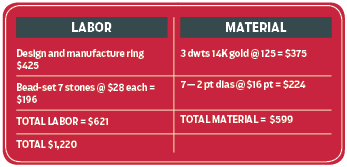Higher metal prices may require you to adjust the way you sell custom.
[dropcap cap=A]cross the country jewelers are still repairing and making new jewelry; custom design, in particular, remains strong. But you might have found your closing rate dropping because of rising metal prices.[/dropcap]
Don’t fret, because custom still has a terrific return on investment, although you probably need to tweak your closing strategy.
To understand the situation better, let’s assume the average custom sale is $1,000 to $3,000 while a typical showcase sale, including bridal, is $1,000. When you make a sale from the showcase for $1,000 you have to have on hand a certain amount of inventory. Let’s assume $500,000. Yes, half a million dollars to make a $1,000 sale.
In comparison, the average store keeps about $5,000 in grain, sizing stock, findings, small stones inventory to support custom jobs, because most of the parts and materials are ordered according to the particular job. For a $1,000 custom sale you are probably also looking at about one week’s jeweler’s wages.
So, here’s how to handle customers who have sticker shock.
Advertisement
When quoting a custom job do not quote a gazillion prices. Many of you are bench people and think in procedures. I’ve seen too many people quote like this:
Mrs. Jones, the cost to make your ring is the following: design fee; CAD fee; wax-cutting fee; casting fee; finishing fee; setting fee; gold grain fee; stone fees.
Ever have a customer say, “Thanks, but I’ll just take the wax. My husband can cast it.”
No! These should be combined and called “To make the ring.”

Also, write the quote on a piece of paper for the customer to see, with one column for labor and another for materials (see our example below). Now draw two arrows pointing to the “Total” box.
Just point to the price and say “and that’s all it’ll be.” Don’t even speak the number; she can see it.
So what happens if the customer says, “That’s a bit more than I wanted to spend”?
Advertisement
If you look back at the price breakdown you’ll see lots of ways to lower the price without discounting. Among the options:
[li] Use fewer stones[/li]
[li] Use smaller stones[/li]
[li] Use her stones[/li]
[li] Reduce the weight[/li]
Then, of course, you can offer to buy any remaining gold and credit her total bill.
But there’s one more thing you should realize. If you bought a $300 ring and sold it from the showcase for $599 (same cost as the materials in this quote) after one year, we would say it had a turn of 1. In comparison, if you design a ring on Jan. 4, order the material, make the ring and deliver it on Jan. 30 you’ve made the ring and sold it in 30 days. Do that once a month and it’s a turn of 12!
This means if you have to discount to make a customer happy, you can discount the material because you have a turn of 12!
Labor, however, doesn’t have a turn. A jeweler can’t really work faster. Therefore, you shouldn’t discount labor because you can’t make up for the time.
So if the customer needs a break in price after trying everything else, deliver your close this way:
Advertisement
“As you know we can’t discount labor, but maybe we can do something on the diamonds and gold.”
If you had discounted the whole job it would be $244. But if you only discounted the $599 in material the discount would be only $120, giving you $124 more while still giving the customer a break.
David Geller is a consultant to jewelry-store owners on store management and profitability. E-mail him at dgeller@bellsouth.net.
[span class=note]This story is from the July 2011 edition of INSTORE[/span]